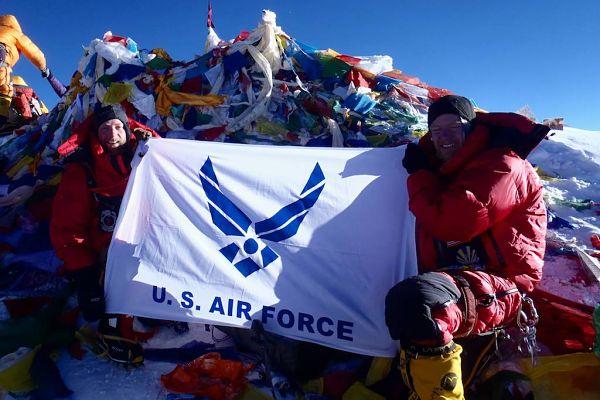When he's not doing pushups atop Mount Everest, Air Force Maj. Robert Marshall tests tilt-rotor Osprey aircraft for acceptance for Air Force Special Operations and the Marines.
The two consuming interests of his career-- climbing and air safety -- are closely related for Marshall. A CV-22 Osprey crash in Afghanistan in 2010 was a catalyst behind the U.S. Air Force 7 Summits Challenge that was completed with the climb of Everest last May.
Atop the world's highest mountain with four others from his Air Force team, Marshall performed one of the rituals he has adopted for reaching a summit.
"I dropped down and did 30 push-ups. Everyone else on the summit was giving me a strange look, like 'What’s this guy on?'" he said.
With the climb of Everest last May, the Air Force team completed the Summits Challenge. It was the first time a team of servicemembers from any nation had reached the highest point on all seven continents, including Mount Elbrus in Europe, Mount Kilimanjaro in Africa, Mount Aconcagua in South America, Mount McKinley in North America, Mount Vinson in Antarctica, Mount Kosciuszko in Australia, and Mount Everest in Asia.
Marshall and Air Force Maj. Mark Uberuaga, co-founders of the Summit Challenge, brought the message of climbing and flying to the Air Force Association's Air and Space Conference last week at National Harbor, Md.
In an interview before their presentation, Marshall said he and Uberuaga initially conceived of the Summits Challenge in 2005 to inspire and demonstrate Air Force teamwork and solidarity. Marshall and Eberuaga are now working up to a new challenge -- reaching the highest point in all 50 states.
Marshall said the concept began to evolve following a crash in March 2005 of an MC-130 aircraft flown by the Air Force Special Operations Command in Albania that killed nine aboard, including several friends.
Another crash that year in Iraq killed two of Marshall's Air Force Academy classmates. Then in April 2010, a CV-22 Osprey crashed in Afghanistan killing four.
Among the fatalities were two of Marshall's friends from the Florida-based 8th Special Operations Squadron -- Air Force Maj. Randell D. Voas, 43, of Lakeville, Minn., and Senior Master Sgt. James B. Lackey, 45, of Green Clove Springs, Fla.
From that point on, the Summits challenge became a mission to honor fallen comrades and raise money for military charities.
The crash in Albania of the MC-130 -- the type of aircraft he was initially trained to fly -- was one of the first time in Marshall's life he realized he was not indestructible. He told himself: "If you're going to do something in life, do it now," Marshall said.
Despite his background in fixed-wing aircraft, Marshall was chosen to become an Osprey pilot and was among the first to fly the CV-22 Osprey in Iraq in 2007. He flew Ospreys on a second tour in Iraq and then one in Afghanistan. He saw similarities in the demands made by mountain climbing and flying the revolutionary tilt-rotor aircraft in combat.
"[In climbing] you're involved in risk management. You can't get away with bad decisions. The mountain is the ultimate equalizer," Marshall said.
The risk management was much the same with the Osprey, he said.
"That is the most complex aircraft out there today. It was quite a challenge," Marshall said.
However, the risks are outweighed by the Osprey's capabilities, he said. Marshall, 34, now works as an acceptance pilot for the Osprey in Amarillo, Tex., where Bell Helicopter finishes the manufacture of the Bell-Boeing Osprey.
"We take the planes at the factory, test fly them and then deliver them to either the Marines or the Air Force," Marshall said.
He retained his confidence in the Ospreys despite the Afghanistan crash of the CV-22 on April 8, 2010, near Qalat in southern Zabul province. In addition to the four fatalities, 16 others aboard the aircraft were injured.
In his report on the crash, then-Brig. Gen. Donald Harvel, board president of the first investigation into the incident, noted "unidentified contrails" that were seen seconds before the crash, possibly indicating engine failure. However, then-Lt. Gen. Kurt Cichowski, Harvel's superior, ruled that pilot error was the most likely cause of the crash.
"Everybody in the community -- we wanted to know what happened -- but we'll never really know," Marshall said.





























